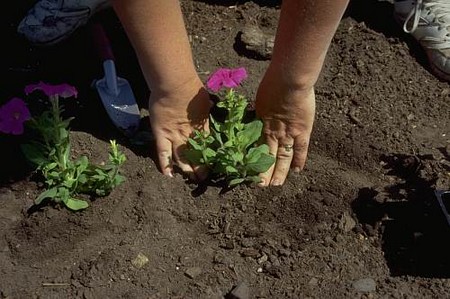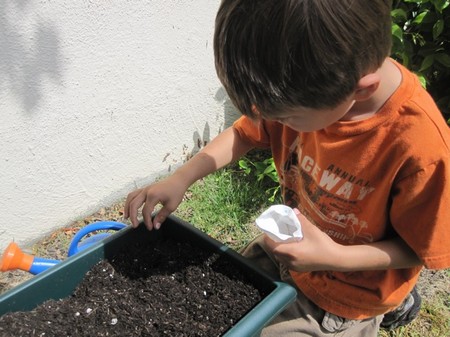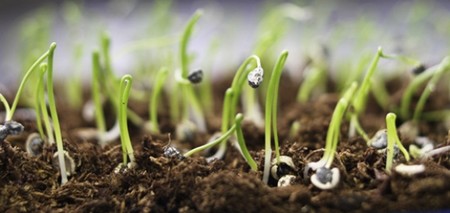Some vegetables are always sown directly into the ground or compost where they are to grow, notably carrots and parsnips, radishes and spring onions. Most other vegetables can either be sown direct or started off in pots, then planted out.
In many ways, sowing straight into the soil is easier as it saves having to look after large numbers of small plants in pots. However, direct-sown seedlings are more vulnerable to soil pests and diseases so it can be risky for expensive seed. Also, you have to wait for the soil to warm up, and this can delay sowing.
When to sow
Some vegetables are very hardy and can be sown outdoors early in the spring, while others are susceptible to frost and should not be sown outdoors until after the last frost normally occurs. Up to two weeks’ extra growing time can be gained by sowing outdoors early under cloches.
Preparing a seedbed
Remove large stones, weeds or weed roots and break up large lumps of soil, either with the back of a garden fork or using a chopping action with a soil rake.
Using a soil rake with a steady but gentle push-pull action, work the surface of the soil until it has a fine, even texture and is flat and level.
Set out a garden line or pegs and string to mark the position of the rows. Use the correct row spacing for each vegetable. When planting different types of crops next to each other, allow for the different spacing. For example, if one crop needs 30cm and the next 60cm, leave 45cm between them, so the larger crop does not swamp the smaller one.
Seed drills and bands
A seed drill is a narrow trough into which you sow. You can use a narrow trowel (a pointing trowel is ideal), a cane or stick, or the corner of a draw hoe or soil rake. The seed drill is usually 1.5cm deep. If the soil is very dry, dribble water into the bottom of the drill and allow it to soak in for a few minutes before sowing Open the seed packet and the inner foil packet carefully. Tip some seed into the palm of your hand. Take a pinch at a time and sow as evenly as you can into the bottom of the drill.
Carefully draw soil over the seed drill to cover it. The soil should not need to be watered until the seedlings emerge. Some vegetables, such as radishes, spring onions and peas, are best sown in bands rather than single rows. Use a draw hoe with a blade 10 or 15cm wide to draw out a shallow trough. Sow the seed thinly so that they are evenly scattered across the width of the band.
Thinning out seedlings
As soon as the seedlings are large enough to identify, start to pull out any that are surplus (this is called thinning out). Start by thinning larger clumps to one or two strong seedlings. Take care not to disturb the remaining seedlings too much. A couple of weeks later, remove all but one plant at about half or a third of the final spacing. For example, if the final spacing is 30cm, leave one plant every 10cm and pull two out later. With care, thinned seedlings can be replanted to fill any gaps. Thinnings of lettuces and carrots can be added to salads.
Transplanting
Some vegetables need so much space to mature that sowing them at their final spacings straight away would be a waste of valuable space. The following members of the cabbage family fall into this category: cabbages, Brussels sprouts, winter cauliflower, kale and sprouting broccoli. Leeks also transplant well. Such plants are often started in a seed bed, prepared as above but sown into short seed drills 15cm apart; the seedlings are thinned to 5-10cm apart. When the plants reach 15cm high they are dug up with as much root as possible and planted into their final position. These bare-root transplants may wilt at first but will quickly establish and grow to maturity. In dry weather, water the seed bed before lifting the transplants with a fork and water them well in their final position.
Categories
Advertisements
Recent Articles
 How to Understand Bed Sizes – A Small Guide
How to Understand Bed Sizes – A Small Guide How to Select Some Must Have Kitchen Accessories
How to Select Some Must Have Kitchen Accessories Best Way to Change a Car Tire
Best Way to Change a Car Tire Best Way to Write an Affirmation
Best Way to Write an Affirmation Best Way to Take Charge of Your Financial Life
Best Way to Take Charge of Your Financial Life Best Way to Survive a Party When You Don’t Know Anyone
Best Way to Survive a Party When You Don’t Know Anyone Best Way to Stop Self Sabotaging Yourself
Best Way to Stop Self Sabotaging Yourself Best Way to Start Journal Writing
Best Way to Start Journal Writing Best Way to Speak with a Powerful Voice
Best Way to Speak with a Powerful Voice Best Way to Simplify Your Life
Best Way to Simplify Your Life Best Way to Respond to a Put-Down
Best Way to Respond to a Put-Down Best Way to Reduce Acne Breakouts
Best Way to Reduce Acne Breakouts Best Way to Recover from Dining Disasters
Best Way to Recover from Dining Disasters Best Way to Quit Your Job Gracefully
Best Way to Quit Your Job Gracefully Best Way to Make Your Own Website
Best Way to Make Your Own Website




Leave a Reply